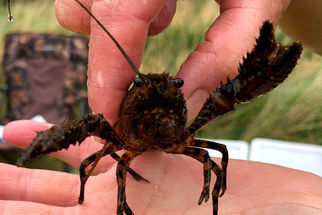
-0-1200-0-0.jpg?k=dd3641aefc)
Lower Waituna Creek Transformation

What is the problem?
At the heart of the Waituna catchment is Waituna Creek. Once a gently meandering waterway, now after 150 years of modifications, in places it is little more than an agricultural drain, straightened and rebattered to stabilise the banks. Incredibly, it is now only a third of its original length. Unfortunately, these actions have reduced its overall biodiversity health and removed much of the habitat for fish.
What is the project?
The Lower Waituna Creek transformation project is a multi-phase restoration project to increase the ecological resilience of Waituna Creek while meeting community aspirations to sustain productive agriculture with effective drainage and provide recreational and cultural opportunities. The project is a workstream within the wider Whakamana Te Waituna programme.

Pat Hoffmann
Waituna Creek Timelapse
What has been done?
In Phase One Living Water chose two 200 metre reaches (500 metres apart) within a marginal strip of land along the Waituna Creek owned by DOC to trial the stream habitat rehabilitation actions. The transformation focused on improving habitat for fish by creating flow variability in the waterway with macrocarpa logs and bundles of manuka wired and anchored into the creek bed to provide shade and hiding places for fish.
An artificial flood plain was created by re-profiling the waterway banks into a two-stage channel. When in flood, the two-stage channel spreads the water, slows the flow-rate and allows sediment and nutrients to drop out rather than being flushed into the lagoon downstream. Extensive riparian planting created shade and habitat for insects that provide food for fish. This transformation was completed in March 2018.
Phase two of the restoration plan will build on the habitat creation concepts of phase one as well as exploring ideas for nutrient and sediment management, and opportunities for recreation and enhancing cultural values while still maintaining effective land drainage. This project will demonstrate the use of different restoration and water management concepts that could potentially be implemented throughout the catchment. It will be a highly collaborative project being co-designed by Iwi, councils, catchment engineers, drainage committee members and the wider community.
What’s been achieved by the project?
Stream surveys over the past three years show positive results and reduced erosion. The presence and abundance of native fish in a waterway is a good indicator of water quality and the general health of the ecosystem. In a recent fish survey the presence of juvenile lamprey was one of several exciting results. Lamprey have very high conservation values, being considered ‘nationally vulnerable’ to extinction, the same category given to the whio (blue duck). There was a significant increase in giant kōkopu and large longfin eels (tuna) which are native species considered at risk due to declining numbers. These results are proof of the success of the habitat improvement work being undertaken in the creek.


What is Living Water learning from the project?
This project is demonstrating the use of different restoration and water management concepts that could potentially be scaled up and implemented throughout the catchment. It is a highly collaborative project involving Iwi, councils, farmers and everyone who wants to be involved. Living Water has learnt people are at the heart of improving water quality and biodiversity. Only by working together at a catchment level and accessing all the available data to make systemic changes to waterway management can real improvements in freshwater quality be achieved. The restoration project has improved riparian and terrestrial habitat which supports fish diversity and abundance without effecting drainage. Living Water recognises nature needs space in productive landscapes, rather than being constrained or squeezed out. Farm and catchment planning should be based on restoring natural ecological systems and processes to achieve positive outcomes for water, climate, soils, biodiversity and farm profitability. While the future for farming will be different, farming and freshwater can both thrive in productive landscapes.
Links to other information and resources
Construction of instream habitat structures, bank re-profiling, and plantings in 2018, here
Fish and habitat monitoring completed March 2018 and March 2019, video and story here
Kokopu moved downstream in Feb 2018 due to extreme drought - vlog here
Giant kōkopu found in lower Waituna Creek for the first time in seven years - stuff.co.nz article
Research to study fish populations in Waituna Creek following lengthy lagoon closure - article here
